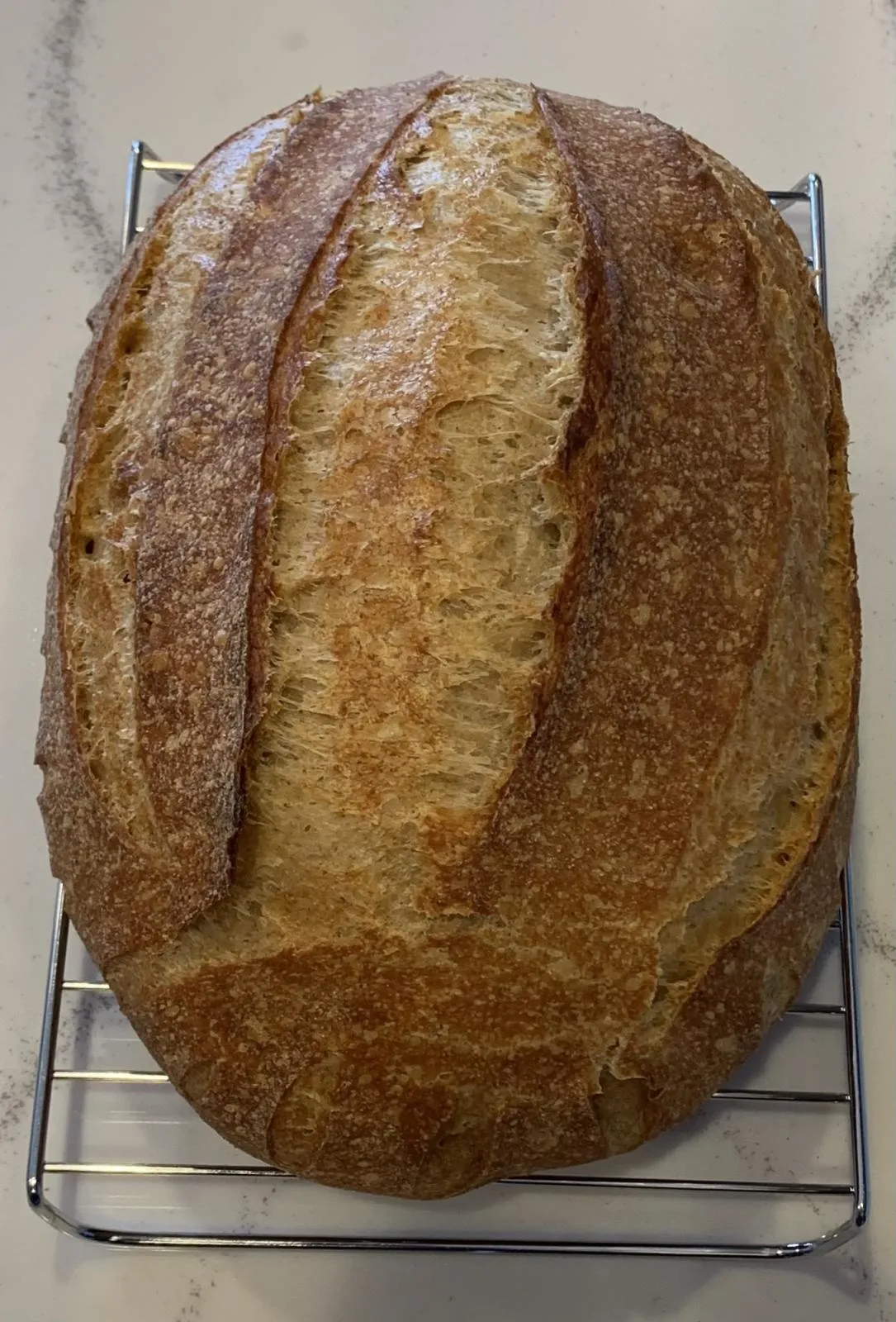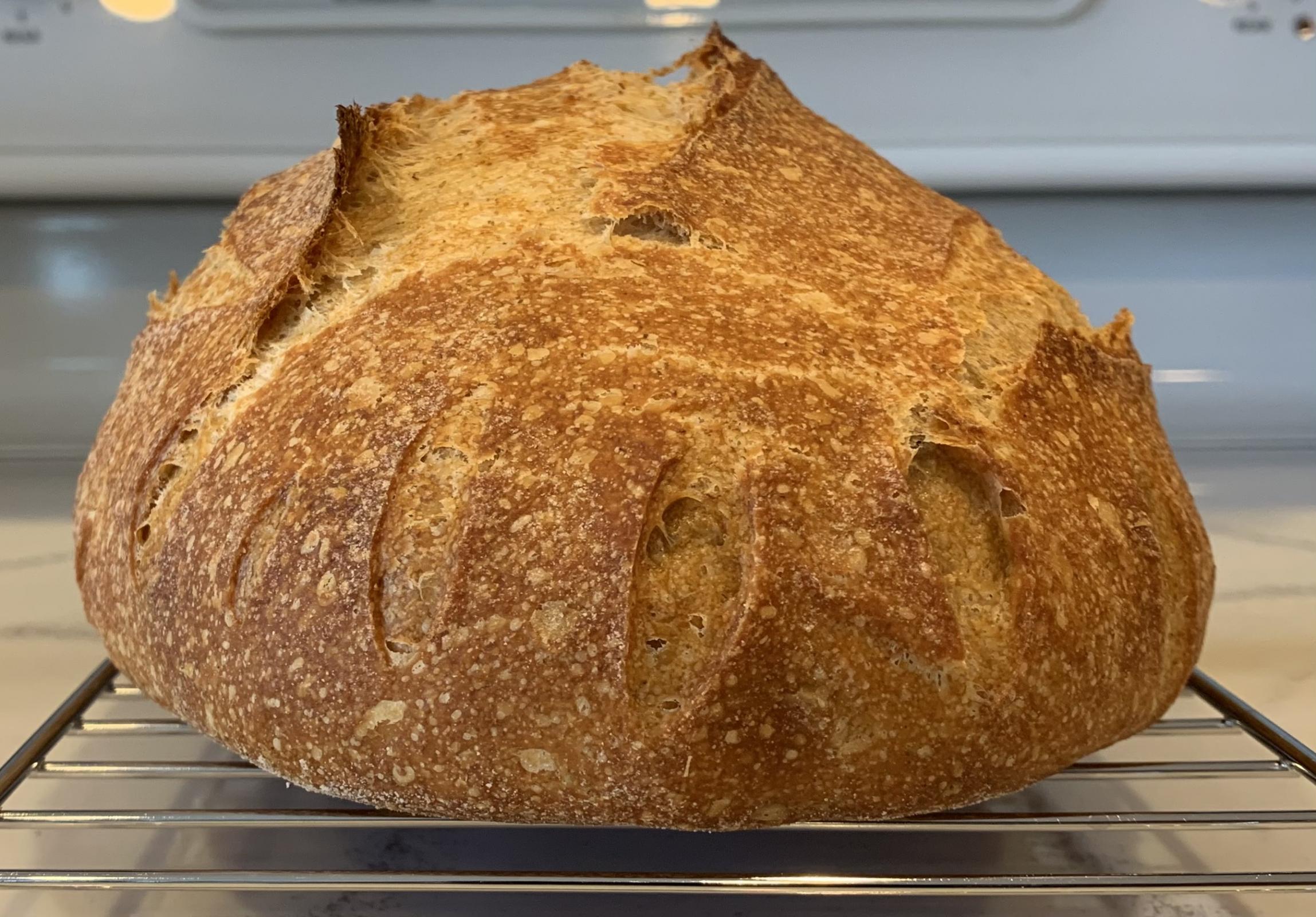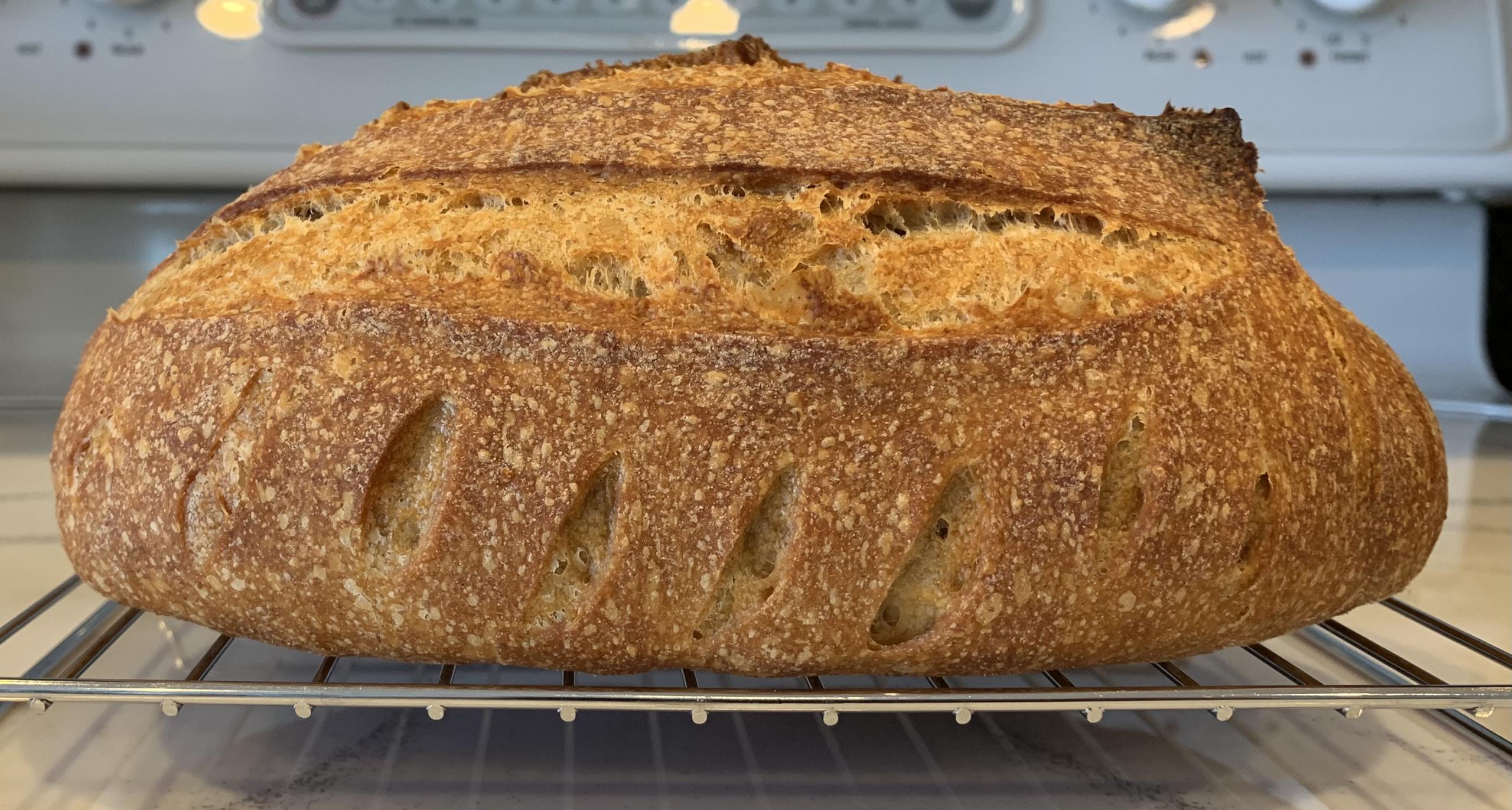
Long week at work and wanted to do a simple bake to start the weekend before trying my Go Out of Your Comfort Zone CB tomorrow. I got this recipe from Abe, and it works really well. Has room for flexibility on the flour selection. I just got a bag of barley flour in, so I added some of that into the mix this time. First time using barley flour with an AP/Bread flour base (have only used it with WW before this), and the aroma of the barley definitely comes through more on the finished bread.
Method is similar to a 1-2-3, but much lower inoculation and longer bulk ferment. Mix and develop medium gluten at the most. Despite the barley being low on gluten, this came together really fast. Just a few turns of hand kneading is all it took. Just stretch and folds after that to continue gluten development. Woke up for a few minutes in the middle of the night, so gave it a quick bowl S&F then before it got too puffy.
Tried a new scoring pattern to get good bloom and expansion, but keep the gas flow uniform vs channeling it to a single score line. Will see how it worked later today/tonight. Hoping for a sandwich loaf type crumb with a few open spaces.


- HeiHei29er's Blog
- Log in or register to post comments
Your formula is very interesting to me.
You used 1.75% Pre-fermented flour and Bulk Fermented ~11 hr @ ~70F. Your spreadsheet shows no levain. That doesn’t seem like the BF would have been long enough. The temp seems low for that duration and so little sourdough. I may be learning something new.
IF you considered your dourgh a levain it would comprise ~17g SD + 333g water + 475 Flour (20% whole grain). That is ratio of 1 part starter to 28 parts flour.
I have baked well in excess of 100 loaves using 2% Pre-Fermented Flour and BF 16-17.5 hr @ 77-79F. Keep in mind, this extreme fermentation is way over doing things (excess fermentation) for the purpose of super sour lactic flavor.
Your bread looks good!
It will be interesting to see the crumb shot.
Danny
Thank you Dan. I will admit wholeheartedly that I don't understand it myself and it was the purpose for this post. The first 2 hours was at 73-74 degrees in my kitchen while I was doing initial folding. Moved to the basement for overnight ferment and put it near the floor, which is in that 69-71 range on any given day. Personally, I don't understand how the small inoculation can have a loaf ready in 12-15 hours, but a full levain can take me at least 8 hours to get through fermentation. Vermont Sourdough might be on my bake schedule again for the Go Out of Your Comfort Zone CB because I still haven't got it "right"! Abe shared this with me early on in my SD adventure when I was struggling with Vermont Sourdough and getting my starter lined out. I was convinced it was my starter. He had me do this recipe to show me my starter was ready for baking. I've done it numerous times and it's always in that 12-15 hour range.
I have a whole rye starter that I feed once a week at 4:22:20. I let it peak stirring once or twice during the 9-10 hours it takes. From there, it goes back in the refrigerator.
Everything else is as you see. I did not use an aliquot jar this time, but I estimated I was somewhere around 75%+ expansion when I pre-shaped (the downside of not using the aliquot, but wanted to do this one by "feel".).
It was cooled enough, so made a couple slices. Probably a little underproofed and could have used another hour during bulk. However, all of my bread eating is as toast or grilled sandwiches, so this works pretty well.
Well done Troy, I agree with you, it is a bit underproofed. Are you happy with the flavour? I haven’t baked with barley flour at all yet.
Benny
Haven't tried it yet Benny. Had some bread from last weekend that I wanted to use up first. Will let you know after I do. Smells good though, so pretty confident it will taste good. Maybe just a bit "sweeter".
What indicators in the crumb shot are leading you to under proofed? I am trying to learn and in no way challenging your evaluation.
I was expecting an under proofed loaf (according to the given formula and fermentation info), but if the crumb shot from Troy’s bread was viewed without any other information I would have guessed a little over proofed. I have decades of avid bread baking experience. Speaking for myself, I often lack confidence when it comes to evaluating the under/over fermentation of a crumb shot.
Because of this, I started Googling and found a great video from our good buddy Tom Cucuzza.
https://youtu.be/4yM-gKlGX5Y
For those who have not seen Tom’s videos, his library is extensive, super informative, and excellent.
https://youtube.com/channel/UCvFd727zQvioesPXe3eKkfg
Dan, I am not an expert, however, I have baked plenty of underproofed and overproofed bread now and I believe I’m a fair evaluator of crumb. Troy, please take no offense to the following comments, I mean no harm. As I said I think it’s only a little bit underproofed, in more extreme cases (remember my first sourdough leavened baguettes?) you’ll have those huge tunnels in the upper ⅓ of the bread. Mostly I look at density of crumb and try to see what the alveoli look like. Throughout the crumb the alveoli are very small and the crumb looks dense. That is the biggest indicator to me.
Benny
Benny, if a bread was over proofed wouldn’t you expect to see the smaller holes (tighter crumb) also? Are the slightly larger pockets indicative?
Often times I evaluate the outside of the loaf - the bloom, spring, and ears. I see so many differing and opposing opinions of fermentation from various bakers. It is not unusually to read a post where some say over and others say under fermented when viewing the same slice.
I find that I am a good judge of my breads but evaluation using images from others is often not so clear.
The subject remains mysterious to me.
I agree that viewing photos of bread is much more challenging than judging our own, we also know the exact steps that we followed and have an idea if we think we may have gone over or under just based on our process. The outside of a loaf as you say is super useful to see in addition to the crumb. I often see on the outside an exaggerated over spring that is sometimes peaked with underproof, but flat or poor over spring with over proofing.
The crumb though to me is pretty much very tight with tiny air bubbles for under proofed. Overproofed usually you don't have those tight tiny bubbles, the proofing has led to good sized bubbles so not usually with tight crumb in my experience. Then also signs of gluten breakdown the more over proofed it gets. Often right under the crust you see the gluten breakdown with broken gluten sheets leading many alveoli to coalesce into larger ones. Whereas with quite underproofed, usually you'll get big tunnels in the upper third of the crumb. I'm sure those aren't all the features, but they are what I usually look for to know if I've gone over or under.
My recent whole grain loaves are good examples of over proofing especially the first 100% whole red fife black sesame. Quite flat and in fact the centre of it droops down. The crumb is actually quite nice and open especially for 100% whole grain, but the profile is super flat.
It's taken a while for me but I've tried really hard to be able to identify over vs under in order to know how to adjust my baking. In particular pursuing the whole grain bakes is forcing me to look at it even more closely.
Not sure that helps or not Dan. Again, there are better bakers here at identifying over vs under.
Benny
No offense taken. :-)
I think you're spot on. It is a little on the dense side. If I zoom in, I can see very small bubbles formed. Another hour or so was needed to let them develop a little more.
Benny,
I finally tried this bread this morning. I don’t notice a strong flavor from the barley, but I’ll also say I probably don’t have a very refined palate either.
Two things that did surprise me though...
1) There is no noticeable sour flavor. Not sure if that’s due to the flour blend or another sign it was under fermented.
2) The texture of the crumb is quite soft. Not at all chewy like I expected. That was just one end piece for toast though. Will see if that holds through the loaf.
I was just looking at the photo you posted of the sliced loaf, I am wondering now if you're getting enough heat into the bottom of the loaf. The bottom crust seems paler than it ought to be Troy. How low in the oven are you baking?
I’ll take a picture during my next bake, but I have it very low in the oven. I have a large cookie sheet shielding the upper element and the roaster pan sitting on a pizza stone. It’s possible that I didn’t let the stone warm up enough.
Nice bake and spread sheet you have there, I was making one too! like what Dan said you've missed adding info about your starter..
Thank you much! Here is a link to a template of the spreadsheet I use. You just need to save a copy of it to your Google drive so you can edit it.
16.7g of mother starter was added during the mix stage and that's it. No levain is used in this recipe.